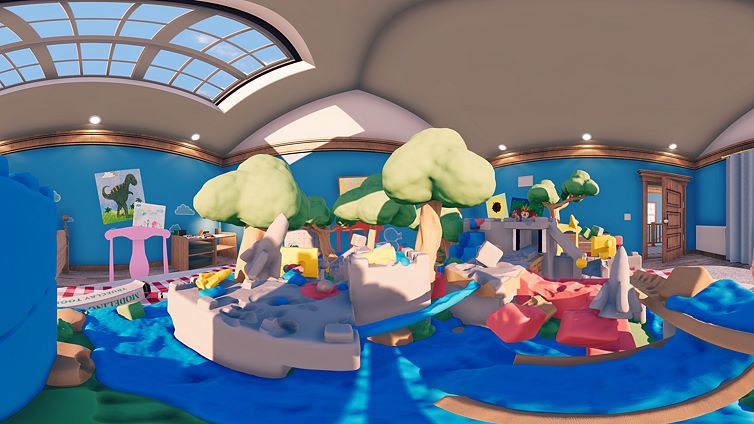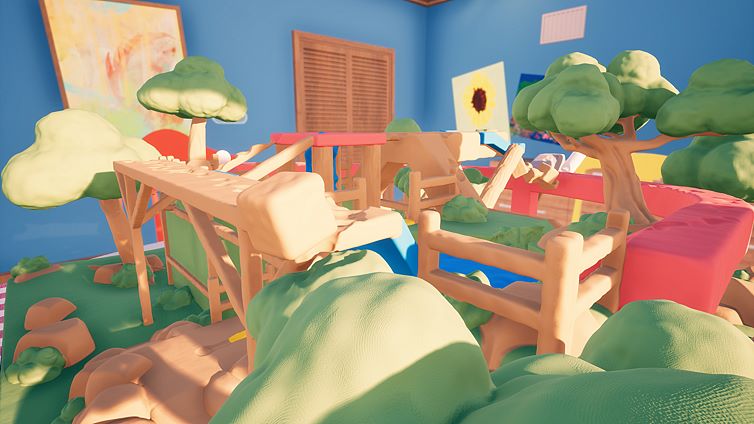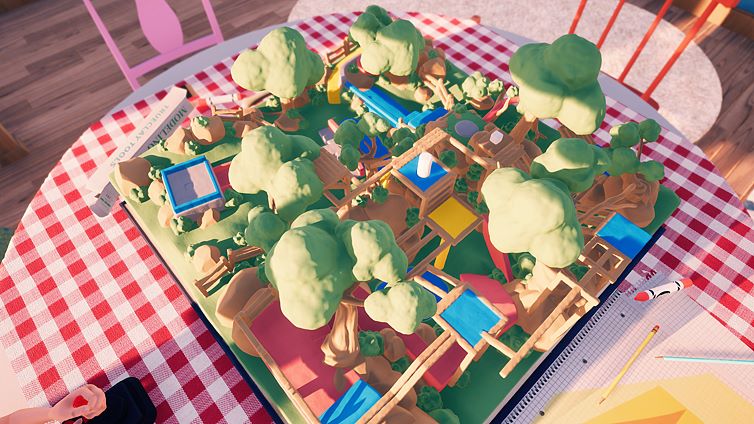 Claybook
Claybook
Developer: Second Order
Publisher: Second Order
Do you remember playing with Play-Doh when you were a kid? Or maybe you are a young (or old) gamer who still plays with it? Do you remember building the craziest worlds, tools, animals, castles and much more? Now you will have the opportunity to relive this memory on your Xbox One! Developed by Finnish independent studio Second Order, Claybook left game preview and is now available for everyone! In this very original game, you will shape and reshape the world in 20 different chapters of colorful books, while admiring some incredible visuals. Prepare to be impressed by what Second Order came up with in their first title.
What do you do?
Claybook is a sandbox game in which you must complete tasks to earn stars that give you access to new levels. Every level is a book with different challenges for you to complete. Challenges consist in destroying some elements, bringing geometric forms to specific places and completing courses against the clock.
What is Good?
- Visuals: The clay looks incredibly realistic. You can see and feel its texture from the screen (I played it on my Xbox One X). All elements are colorful and really impressive on your screen! Except that boy holding a joystick: the way he looks at you gave me the creeps! Let us hope he isn’t based on one of the sons of of the developers. If that’s the case, please, take no offense ?.
- Visuals and gameplay: With jaw-dropping visuals, Claybook has one of the most remarkable physics I’ve seen in a game. Ever. ‘Physics?’, you may be wondering and I say ‘yes, physics’. Everything in Claybook play area is made of clay. You have clay in two physical formats: solid and one more fluid, almost liquid. And the way things behave in this world is impressive. Wherever you roll your little ball (made of clay) over the surface (which is also made of clay), you can see the deformation the ball leaves over the clay surface. And what’s more stunning, the color of both elements (your ball and the surface) starts to mix as the ball accumulates part of the surface, as it would happen in real life! But wait, there is even more: the ball (or cube, coin, duck, rocket or whatever element you’re controlling) can be deformed too, by simply touching other surfaces (if you want to imagine it in a more hardcore way, think about what happens when you drop a ball of clay on the floor. What happens to it? Yes, exactly. This is the deformations I’m talking about).
- Books: Every book represents a different world with a specific theme: you have a candy world, forest world and so on. Each book has 4 different (or levels) tasks to unlock three stars. Stars are used to unlock new levels and books, so you better aim for getting all of them in the early levels. From the beginning, only the first book is available for you but as you progress, you can unlock 20 different levels.
- Music: Claybook has some sweet songs which immediately makes you feel inside a cartoon or animation with that magic only Walt Disney Studios can provide… well, only they could do it. It seems that a Finnish Studio can do it too!
Mixed Feelings
- User created content: The game comes with few books and levels, but it also contains a very robust tool for creating your own levels and share them with the community. One aspect that deserves mentioning is the fact that levels created can be exchanged between different platforms. The problem is that this tool isn’t easy to use and, to make things worse, there’s no tutorial for it. You must try it for yourself to get the hang of it.
- Controlling your clay: You move your ball (or cube, disc or whatever form it’s assumed) of clay in the play area, morphing into different geometric forms or swapping control between different elements like magnets, ducks and rockets to overcome obstacles, according to your necessity. With your left trigger, you can rewind time, leaving a copy of the element you are in control (which is useful to build platforms and stairs to reach higher places. Please note that this copy can’t be controlled), while with the right trigger you can carve the clay under you (which is useful to open tunnels). When controlling some specific elements, the RT is used to interact with them (like firing cannons, making rockets fly or using magnets). But controlling these different elements is no easy task. It’s hard to control your movement and camera.
What is Bad?
- Tasks and challenges: Some tasks include destroying an element in the scenario, leaving a copy of you in a specific spot, swapping control of your element in a specific place, or racing against the clock through checkpoints scattered in the play area. And that’s all. All you are going to do in this game is accomplish these tasks (in very well designed and varied levels, I must add), which feels swallow and boring by the end of the first book. The impression that stays is that the studio developed an incredible asset (the clay and its physics) but was short on ideas about what to do with it, kinda like Microsoft’s Project Spark.

Claybook [Score: 68/100]: With impressive visuals, amazing songs and one of the most impressive physics I had the opportunity to play with, Claybook had everything to be a remarkable experience, but fails to deliver an entertaining experience with swallow missions and tasks that soon become boring. The community can provide some more levels with different tasks to increase its lifespan, so I put my faith on them.
Want to buy Claybook? Click here

With a history of gaming that goes from his old man’s Atari 2600 to his Xbox One, Rafael or RAF687, our Brazilian editor, has a love for games as old as he can remember. He has already spent countless hours in many consoles (Mega Drive/Genesis, Sega Saturn, PS1, PS2 and Xbox 360) and is always ready for more (as long as his wife is asleep). Raf has been writing for LifeisXbox since 2017, with a passion for games of almost all genres – though we know he has a special place in his heart for RPGs, racing games and anything that includes pixel art. Writing about games has always been a childhood dream to Raf, dream that he has fulfilled reviewing games for you here. You can drop him a message at Twitter, Facebook or Xbox Live at any time.








